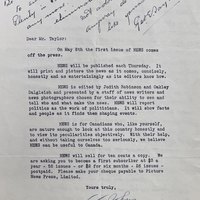Turning Up the Transparency on Politicians
Wartime censorship in the press was a prevalent concern of NEWS. In a letter written in 1941 to subscriber Mr. L.E. Fleck, Judith Robinson noted that her newspaper aimed to provide honest speaking.[ix] Robinson believed that Canada needed a paper that produced historic authenticity, and she was determined in her search for individuals who shared the same understanding. She knew it was imperative—"for the sake of this country"—that Canadians were supplied with clarity of information about the war,[x] especially when the standard of the war effort, as mentioned on the previous page, was considered.
In 1943, NEWS sent a letter to a Mr. Taylor, describing the objectives nad specificities of their press. They aimed to present politics as they were—facts and people—to those who sought honesty.[xi] Robinson's goals for her paper were in line with her desire to remove press censorship by which he was determined to establish a useful platform that expressed the truth in politics. It is worth noting that in both letters, Robinson was requesting for a subscription to be made to NEWS and presenting reasons why it could be a successful business - showing that not many readers were interested in the topics presented at the early stages of NEWS. In fact, the letter to L. K. Fleck seemed to be a reference from a third party, further displaying the difficulties Robinson may have had when finding viable sponsors.
Her attitude and approach towards news delivery remained as unfiltered as it was in the Globe and Mail. Thus, it was evident that Robinson's establishment of the paper was based on the desire to truthfully express the nature of Canadian wartime politics. She sought a program that would help her, and fellow Canadians convey the truth of their conteporary issues, and when she did not find that at her previous institution, she created one. These letters also exemplify Robinson's determination to use her agency to garner the tools necessary to create the factual paper -- the letter to Fleck shows that she considered the
These letters also exemplify Robinson's determination to use her agency to garner the tools necessary to create the factual paper -- the letter to Fleck shows that Robinson considered the paper’s circulation: reaching as far as the western coast of the country through investments from subscribers and officials.[xii] Moreover, the letter to Taylor highlights NEWS’ objectives. Thus, Robinson was strategic and directive in the creation of her platform.
Despite Robinson's attempts and determination to be transparent in the depiction of Canadian socio-political issues, she herself, was motivated by her political allegiances and opinions when writing "This is on the House." Referring to the exhibit by Brennan, Via, Subyeta, and Kit, Robinson reflected her political motivations through her writing. Robinson presents herself not as a neutral party as she does not mention the full political climate between Britain and Canada. She sheds light on important political figures such as Lester B. Pearson, criticizing them in their role in the Canadian Parliament. Ironically, Robinson bluntly finds fault with Britain without considering other perspectives. This is an interesting contrast to her own objectives as a writer and newsletter owner. However, these incentives allow for better understanding of personal agendas and how they are framed by opinions of contemporary issues.
The extra context offered by their exhibit thus demonstrates how bias in media is often hard to avoid—even with her claims that Canada required plain speaking for the good of its citizens, it is important to thoroughly analyse Robinson's claims over political matters, no matter how logical they may appear.
![To L. E. Fleck [2]](https://expo.mcmaster.ca/files/square/1c2f1bde6759d3239e8858a0f45470869947c926.jpg)
